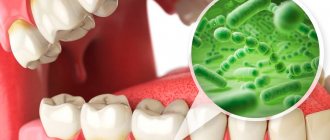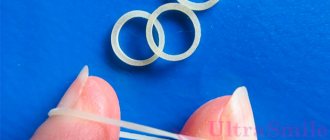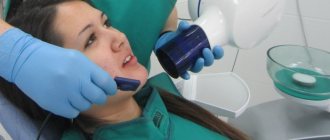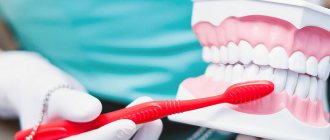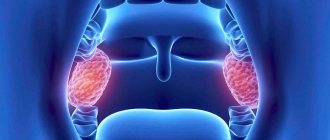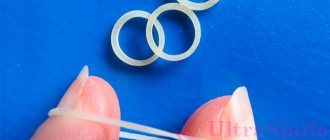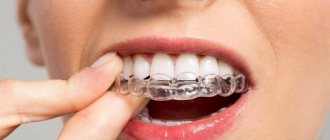When starting treatment with an orthodontist, patients should be aware that they will then have to go through a retention stage to consolidate the result. Although this stage is much easier to tolerate than treatment (we’ll talk about that later), it is nevertheless worth remembering that at this time certain efforts are required from the patient.
Both after braces and after aligners, a period of consolidation of the result is needed
Who needs the retention stage and why?
To one degree or another, this stage is necessary for all patients, since it is necessary to secure the roots of the teeth in a new position.
Human bone tissue is constantly renewed: some cells die, others appear in their place. At a young age, this process occurs quickly, but slows down with age. In addition, the older the patient is at the time of treatment, the more years the roots of the teeth have become accustomed to the incorrect position.
If you start correcting your bite at the age of 16, it will turn out that by the start of treatment the roots of the teeth have been in the wrong position for only about 4 years (if we assume that the age of formation of a permanent bite is approximately 12 years). But many people turn to an orthodontist at the age of 30–35 and even later. Although there is no age limit, just imagine - you need to correct the position in which your teeth have been for more than 20 years!
Teeth can be in an incorrect position for 20 years or more, and the movement of individual teeth can be up to 1 cm
It is not surprising that after removing braces or stopping wearing aligners, teeth will immediately tend to return to their old place. To prevent this, a retention stage is needed.
At this time, the bone tissue around the roots is gradually renewed and compacted. The younger the person, the more active this process is.
Orthodontic treatment in the retention period
The retention period begins immediately after the removal of braces and other orthodontic structures that move teeth and straighten the dentition. At this stage, it is important for the patient to be ready to continue treatment and understand its importance. Often the retention process is not given due attention: a person already sees the result, his teeth are already in the correct position, and additional actions seem unnecessary.
If retention devices are not installed after removing braces, the achieved treatment results will be quickly lost. The tissues displaced under the action of braces will “strive” to return to their original position: the same as it was before the correction. Pathologies of the dental system can not only return in full, but also become more serious, since the use of braces to correct the bite throws it out of balance. Refusal of the retention period provokes occlusion disorders, the jaws stop closing normally, and the chewing load is distributed incorrectly. This can accelerate the abrasion of enamel, lead to the appearance of periodontal diseases, disturbances in the functioning of the temporomandibular joint, etc.
What orthodontic structures are used at this stage?
A permanent retainer is usually placed on the lower teeth. This is a thin metal wire made of the same alloy as the braces arch and about the same thickness. The retainer is installed from the reverse (lingual) side using filling material. The surface of the retainer and fastenings is smooth, does not interfere with cleaning and is not felt at all.
This is what a dental retainer looks like
But the retainer only holds the lower teeth in place. To stabilize the position of the upper ones, use a transparent mouth guard. It is made from impressions that are taken from the teeth immediately after treatment is completed. That is, the mouthguard repeats the ideal shape of the dentition that was obtained as a result. The mouth guard must be worn at night.
Retention period in dentistry
The retention period is a period of stabilization of the position of the teeth and adaptation of the surrounding tissues of the oral cavity after orthodontic treatment.
The causes of orthodontic pathology in most cases are functional disorders of the facial and chewing muscles, as well as the muscles of the tongue. Myofunctional disorders lead to malocclusion pathology, disruption of the shape of the dentition and incorrect position of the teeth!
During orthodontic treatment, changes occur in the shape of the dentition, the position of the teeth, the relationship of the jaws, the occlusal contacts change, and the bone structures and ligaments surrounding the teeth are rebuilt. Within 12-18 months after the end of orthodontic treatment, adaptation and relative stabilization of the bone structures and ligamentous apparatus of the teeth occurs, but changes in the function of the muscles in the oral cavity and facial muscles either do not occur, or occur much longer, about 5-7 years! It is also necessary to understand that the tooth and bone are a movable connection through elastic and collagen ligaments. Therefore, the retention period after orthodontic treatment essentially lasts a lifetime! But don't be afraid of this. The retention regime changes and over time turns into routine dental care.
How long does this stage last?
The standard period for adults is twice as long as the treatment lasted. That is, if the active stage of tooth movement has passed in 12 months, the retention stage lasts at least 2 years. But this is an average period. In each specific case, the doctor determines the duration of the consolidation stage individually.
It is important to note that there is no way to determine whether the teeth are securely anchored in their new location. And if you stop the retention stage too early, then there is a risk that in a month or two the teeth may move into the wrong position, and this will happen unnoticed. Most likely, not to its original state, but even a slight deviation can make the smile less ideal.
Therefore, it is much better to play it safe and wear stabilizing aligners a little longer, but maintain the result.
Currently, even the treatment process itself is quite simple and comfortable. The aligners cause minimal inconvenience and are very easy to get used to. And compared to the stage of active tooth movement, the retention period is even easier, because during the daytime there is no need to wear aligners at all.
Standard retention mode in "Stomka"
For complete information, here is the standard retention regime after orthodontic treatment at the Stomka clinic:
- The priority device for effectively maintaining the results of treatment is a removable retainer-mouth guard.
- For the first month, the patient uses removable retainers 22 hours a day.
- For the second and third months, the patient uses removable retainers for 12 hours a day.
- In the following months up to 12 months, the patient uses removable retainers for 8 hours a day (at night).
- After the first year of retention up to 1.5 years, the patient can use removable retainers 2-3 times a week.
- After 2 years of retention, the patient uses removable retainers 3-4 times a month at night. This scheme can be adjusted depending on the complexity of treatment and the characteristics of the pathology.
The patient visits the orthodontist once every 6 months; be sure to have retainers with you!
Removable retainers are manufactured every 6-12 months depending on their hygienic and structural condition.
Due to the fact that about 50% of patients lose removable retainers in the first months, we strongly recommend making 2-3 sets of retainers for the upper and lower jaws after orthodontic treatment. This guarantees reliable protection against relapse of pathology!
This information is relevant for maintaining the results of treatment carried out by any orthodontic device (aligners, braces, orthodontic plates, etc.).
In some cases, an optional retention method can be used: fixation of a non-removable retainer splint to the inner surface of the incisors and canines. This retention method cannot be used without a removable retainer.
This information is generally accepted for most cases of retention after orthodontic treatment throughout the world. The cost of maintaining a retention period and retention devices is an individual parameter for patient treatment and may vary depending on the complexity of the pathology.
The article is related to the following services
Orthodontic treatment with braces
Orthodontic treatment with clear Invisalign aligners
What should be done at the retention stage?
The point of this stage is to gradually strengthen the jaw tissue along with the new position of the roots of the teeth. It is impossible to speed up this process. But you can help your teeth during this period:
- Eat more solid foods - raw vegetables and fruits. This is a kind of “charging” that strengthens the gums and roots of the teeth. When teeth are stressed by chewing solid food, they perform their function to the maximum, which means that the roots receive sufficient blood supply in return. This helps maintain healthy teeth and gums.
Hard raw vegetables and fruits - as an “exercise” for teeth
- Eat foods that contain enough calcium and phosphorus. These are the main building materials for bone tissue. They are found in cottage cheese, cheese, turkey, fish, nuts, and sesame. The decision about whether you need to take additional mineral supplements in the form of tablets is made after consultation with your doctor.
- Do not forget about visiting an orthodontist once every 6 months, at least in the first year and a half after the end of treatment. It is much easier for the doctor to notice the slightest deviations in the position of the teeth from the result that was achieved. If necessary, the doctor will suggest correction methods or recommend extending the retention period.
Other articles:
- Can veneers correct crooked teeth?
- Lingual braces 2d
- What can aligners do?
The longer the corrected position of the teeth is maintained (from 2 to 5 years in adolescents), subject to proper treatment, the more secure the occlusion will remain throughout life.
For a long time, scientific research has been carried out to analyze the diagnostic data of hundreds of thousands of patients, made dozens of years after the end of orthodontic treatment. As a result, it was found that a satisfactory position of the lower jaw teeth 10 years after retention was maintained in only 30% of patients. The reason is non-compliance or violation of the retention regime, individual characteristics.
Causes of tooth relapse after orthodontic treatment:
- Unextracted wisdom teeth, which cause teeth to move forward during eruption.
- Excessive forward inclination of the front teeth and tension in the orbicularis oris muscle pose a risk of potential relapse. In these cases, it is necessary to stabilize the resulting position of the teeth throughout life.
- Rotation of teeth around an axis (rotation).
- Expansion between the canines on the lower jaw. The more the distance between the canines increases during active treatment, the more it shrinks after treatment, causing crowding.
- High instability of treatment results without removal after 5-10 years of retention is observed in 70% of cases due to a violation of the principle of maintaining the original shape of the lower arch during treatment. Dental arches tend to return to their original shape over time. Fabricated arches exactly match the shape of the mandibular arch only 50% of the time. While maintaining the original shape of the lower arch during treatment, satisfactory stability, according to other authors, is found in 79% of patients.
- Direction of jaw growth. If orthodontic treatment ends at the age of 13-14, then with a vertical type of jaw growth and an open bite there may be a relapse; with a horizontal type, the incisal overlap deepens with age. Patients with such malocclusions should be observed until the age of 18-20, when active growth of the jaws ends.
- Uncorrected functional disorders of the dental system: disorders of swallowing, chewing, speech, tongue articulation.
Retention mode
Once the teeth and mandible are in the desired position, ongoing stabilization is necessary to allow the periodontal, osseous, and muscular tissues to adapt. Lifelong retention is indicated for expansion (especially in the lower jaw), closing gaps between teeth, severely rotated teeth in adults, and periodontal diseases to resist lingual-labial forces.
| Wire retainer | Removable retainer | Removable mouth guard |
In all cases, a non-removable wire retainer is installed on the lingual surface of the lower and upper jaw in children and adolescents under 22-24 years of age, for an average of 5 years, in adults for life. The second mandatory element of retention is a removable plate with a vestibular arch or a transparent mouthguard.
Classic recommendations for using a removable orthodontic retainer:
- For 6 months, wear 24 hours a day.
- For the next 1 year only at night
- Over the next 2 years every other night
- Adult patients monitor the stability of their teeth twice a month throughout their lives.
During the retention period, it is necessary to be observed, on average, once every 6 months to monitor the established treatment regimen. Relapse occurs in most cases, both with and without extraction of teeth to a greater or lesser extent; there is no clear parameter to predict or record relapse after orthodontic treatment. Therefore, it is necessary to follow all the orthodontist’s recommendations to prevent relapse.
How does the retention stage proceed?
There are two types of retainers:
- Transparent removable aligners, which are made from dental impressions after treatment.
They are well known to those who wore aligners during active tooth movement. In this case, retainers are the last pair of aligners. Those who have had braces receive these clear aligners for the first time. They are made immediately after the braces are removed. Mouthguards cover all teeth - from the front incisors to the “sevens” or “eights”.
Removable mouth guard
- Fixed retainers.
This is a metal wire that looks like a braces arch, only it is shorter. It is glued to the back of the teeth using a material similar to filling. The retainer is not placed on all teeth, but only on the 6–8 front ones. The arc and the place where it joins are smooth, they do not interfere with diction, are invisible externally, do not affect nutrition and, in general, are not felt in any way.
Fixed retainer
Cervical retention cysts: what are they? Treatment methods
A retention cyst of the cervix is formed at the site of the nabothian gland, which secretes a special secretion (mucus) necessary to protect the internal genital organs from infection. When, for some reason, the duct of the nabothian gland is closed (“blocked”), and the internal secretion continues to be produced, a cyst forms.
Thus, a retention cyst (or otherwise called Nabothian cyst ) is a benign formation that arises as a result of the closure of the duct of the Nabothian gland and contains glandular secretion. Externally, it is a convex tubercle of a yellowish or whitish color.
These cysts come in different sizes
: from minor (about 1 mm) to huge (2 - 3.5 cm). Usually small cysts do not manifest themselves in any way. A woman learns about their existence only when visiting a gynecologist. But large cysts can cause discomfort and even cause deformation of the cervix and even infertility (when the cervical canal is blocked and sperm simply cannot penetrate the uterus).
With large retention cysts, the following symptoms may be observed:
- Constant feeling of discomfort in the cervical area
- Unpleasant, sometimes painful sensations during sexual intercourse
- The appearance of nagging pain during menstruation (occurs when the cervical canal is partially or completely blocked by a cyst)
Methods for diagnosing retention cysts
Depending on the location there are:
- Paracervical cysts , located on the outer (vaginal) edge of the cervix
- Endocervical cysts located in the cervical canal of the cervix
Because paracervical cysts are located on the outside of the cervix, they are easy to detect during routine speculum examination.
or using
a colposcope .
(Colposcopy is an examination of the cervix under a microscope. During colposcopy, you can detect the smallest brushes, which are not always visible during a simple examination with mirrors).
Endocervical cysts can be diagnosed only during a transvaginal ultrasound of the pelvic organs , since endocervical cysts are located inside the cervix.
Reasons for the formation of retention cysts
- Inflammatory diseases of the reproductive system (cervicitis, endocervicitis, colpitis, endometritis, etc.)
- Sexual infections (herpes virus, human papillomavirus, chlamydia, ureaplasmosis, etc.)
- Hormonal imbalance
- Trauma to the cervix (childbirth, abortion, surgery, etc.)
- Pathological changes in the endometrium of the cervix (cervical erosion, cervical dysplasia, leukoplakia, etc.)
Is it worth treating retention cysts?
The retention cyst itself is not dangerous. It does not degenerate into a malignant tumor. When diagnosing a cyst during pregnancy, there is no reason to worry: the presence of a cyst does not affect the course of pregnancy.
Nevertheless, gynecologists recommend removing such cysts for the following reasons:
- Review cysts, accumulating secretions, can increase in size
. Either a single cyst can grow, or multiple adjacent cysts can merge into large formations in polycystic disease. - Enlarged Nabothian cysts cause discomfort at rest, discomfort during sexual intercourse, pain during menstruation, and deformation of the cervix. Sometimes they completely block the cervical canal of the cervix, causing infertility .
- Review cysts may contain infection
, especially when the cause of the cysts was an inflammatory process in the genital organs.
In some cases, the infection remains in the clogged glands and the cyst begins to fester and an abscess . - The review cyst sometimes opens spontaneously (cyst rupture) . If it contained an infection, then re- infection of the genital organs , and in rare cases, even the development of sepsis. If a large cyst is opened, a scar may form on the cervix . If a woman plans to become pregnant in the future, the presence of a scar may complicate the dilatation of the cervix during labor or lead to rupture of the cervix in this place.
Treatment methods
To prevent the unpleasant phenomena described above, gynecologists recommend removing retention cysts.
There are several ways to get rid of these formations:
- Removal using a scalpel is a very traumatic method, with a high percentage of postoperative complications, a long recovery period compared to other methods, and requires anesthesia. When cysts are removed with a knife, scars usually form. It is practically not used anywhere and is considered obsolete.
- Diathermocoagulation (“cauterization” with electric current) is a painful method. There is a risk of burns and postoperative bleeding. Usually, rough scars remain at the site of cyst removal, so diathermocoagulation is not recommended when planning a subsequent pregnancy.
- Chemical cauterization with Solkovagin is a painless, bloodless procedure, but is effective in removing only small brushes.
- Cryotherapy – removal of retention cysts with liquid nitrogen. The method is painless and bloodless. With cryotherapy, the retention cyst is not destroyed immediately. Treated with liquid nitrogen, it dies and after a few days comes out through natural channels. A rough scar remains in its place.
- Laser vaporization is a safe, bloodless method with correctly selected laser power, with a minimal risk of postoperative complications and a short recovery period. However, if the power of the laser beam is not selected correctly, burns may occur with all the ensuing consequences. Laser vaporization is usually used for shallow cysts.
- The radio wave method is a non-contact removal of retention cysts using high-frequency radio waves in a narrow range that is safe for the body. The method is painless, bloodless, there is no likelihood of postoperative complications, and no scar is formed. The recovery period is short. The radio wave method is effective in removing cysts of any size.
Medical uses two methods for treating retention cysts:
- Chemical cauterization with Solkovagin - for small cysts
- Radio wave removal using the Surgitron device (more about the Surgitron device >>) – for cysts of any size
Method for removing retention cysts using the Surgitron radio wave apparatus
The peculiarity of the Surgitron radio wave apparatus is that it allows targeted action on the surface of the review cyst, creating a micro-hole similar to the natural duct of the gland.
Through this micro-hole, the contents of the cyst are removed using a vacuum. After which, the formation falls off, and its base is cauterized with an electrode.
After radio wave removal, the likelihood of relapse is practically absent.
All manipulations using the radio wave method are non-contact, that is, the Surgitron electrode does not come into contact with the tissues.
High-frequency radio waves emitted by the electrode of the device specifically affect cells, simultaneously causing tissue dissection and coagulation. Neighboring cells are not damaged. The depth and radius of influence of the Surgitron electrode are 2-3 times less than when using a laser device.
In our medical center, in tandem with the Surgitron radio wave device, we use a Surg-E-Vac smoke evacuator, which:
- removes unpleasant odors
- ensures the absence of smoke and steam during contactless “vaporization” of cells with an electrode
- eliminates the infection released after opening an infected cyst, which ensures the safety of the patient and the doctor
We value the health of our patients and strive to provide the highest quality of our services!
GO TO THE “GYNECOLOGY” >>
Ovarian retention cysts: symptoms
Approximately 80% of all ovarian retention cysts are discovered accidentally during a routine examination by a gynecologist. Despite this, a woman may complain of spotting bloody discharge from the genital tract
in the middle of the cycle, absence of menstruation, heavy menstruation, periodic nagging pain in the pelvic organs, dysuric disorders and disruption of the digestive tract and infertility. Unpleasant sensations may intensify with excessive physical activity or during sexual intercourse.
What if you have to wear it always?
The option that the orthodontist will advise not to give up retainers altogether is possible. This usually happens in adult patients - it is not always possible to completely correct the posture and position of the joints with braces or aligners alone, so the tendency to regression in the state of occlusion (that is, to move again to the wrong position) may persist.
Even after 3–4 years of the retention stage, regression is possible! Especially in adults.
But this situation is worth looking at from the other side. In dentistry, there are not many types of treatment that give results once and for all.
- Even well-installed fillings sometimes need to be changed. Some people last 20 years, but on average 10 years of service is normal. The same applies to bridges and individual crowns.
- Whitening – the result lasts up to 1 year (if you follow the doctor’s recommendations).
- Professional cleaning requires repetition every 6 months, even if you brush your teeth very carefully at home.
- Veneers, like fillings, last on average 10-12 years, and also tend to fall off.
- Conventionally, implants can be classified as “eternal” types of treatment in dentistry, but there are exceptions - the crowns of implants are also sometimes changed.
And an orthodontist deals not with prostheses or implants, but with living tissue. It is quite natural that if the roots of the teeth have already shifted once due to the peculiarities of their structure, incorrect posture or bad habits, this can happen again.
Moreover, if the patient corrected the bite at 35–40 years old. It turns out that he lived with an incorrect permanent bite for about 25 years, so it is quite expected that after 1-2 years of treatment and the retention stage, the roots will not get used to the new position and will tend to the old place!
This is not an argument against treatment, and all the benefits remain with the patient: a smooth, beautiful smile, easier dental care and maintenance of their health, opportunities for prosthetics or installation of veneers. This only means that the retention stage will probably last indefinitely.
Is it possible to wear a mouthguard constantly at night? Of course, yes - it does not interfere with sleep and does not cause any inconvenience. It needs to be updated once a year or even less often, since the shape of the dentition is already unchanged. And a non-removable retainer does not need to be updated at all, except in cases of partial correction.
If you follow the doctor's recommendations, the achieved result is preserved forever. These recommendations are not at all complicated: patients get used to them and do not notice any restrictions in their lives, but their contribution to dental health is very significant.
Other articles:
Is it possible to correct an overbite at an older age?
How to make your smile perfect? Treatment plus aesthetics
Types of orthodontic systems: from plates to aligners
Ovarian retention cysts: diagnosis and treatment
In the oncology clinic of the Yusupov Hospital, the diagnosis of ovarian retention cyst is made by a gynecologist based on complaints, symptoms, gynecological examination and data from additional research methods. When examined on a chair and bimanual examination of the vagina, a doctor in a patient with suspected cystic pathology of the reproductive system can palpate a soft, mobile and painless formation, up to 3-6 cm in diameter. Bilateral cysts are rare and may result from stimulation of ovarian ovulation.
On ultrasound control, the cyst is defined as a single-chamber cavity filled with anechoic fluid. When it is impossible to accurately differentiate between a benign cyst and a malignant tumor, diagnostic laparoscopy is prescribed.
Thanks to the cooperation of doctors at the Yusupov Hospital with European clinics, treatment of any gynecological pathologies has become available according to the latest international protocols. Oncology clinics use both conservative therapy and surgical removal of ovarian retention cysts.
If the formation has not reached a large size, only drug therapy with combined oral contraceptives is sufficient. Observation is prescribed for three months - regular examinations by a gynecologist and ultrasound examinations. In most cases, this treatment is sufficient.
The Yusupov Hospital not only provides high-quality treatment for oncological pathologies of the female reproductive system, but also carries out rehabilitation measures for women who have not yet appreciated the beauty of motherhood. To make an appointment with the clinic's gynecologist, call. The hospital operates 24 hours a day.



